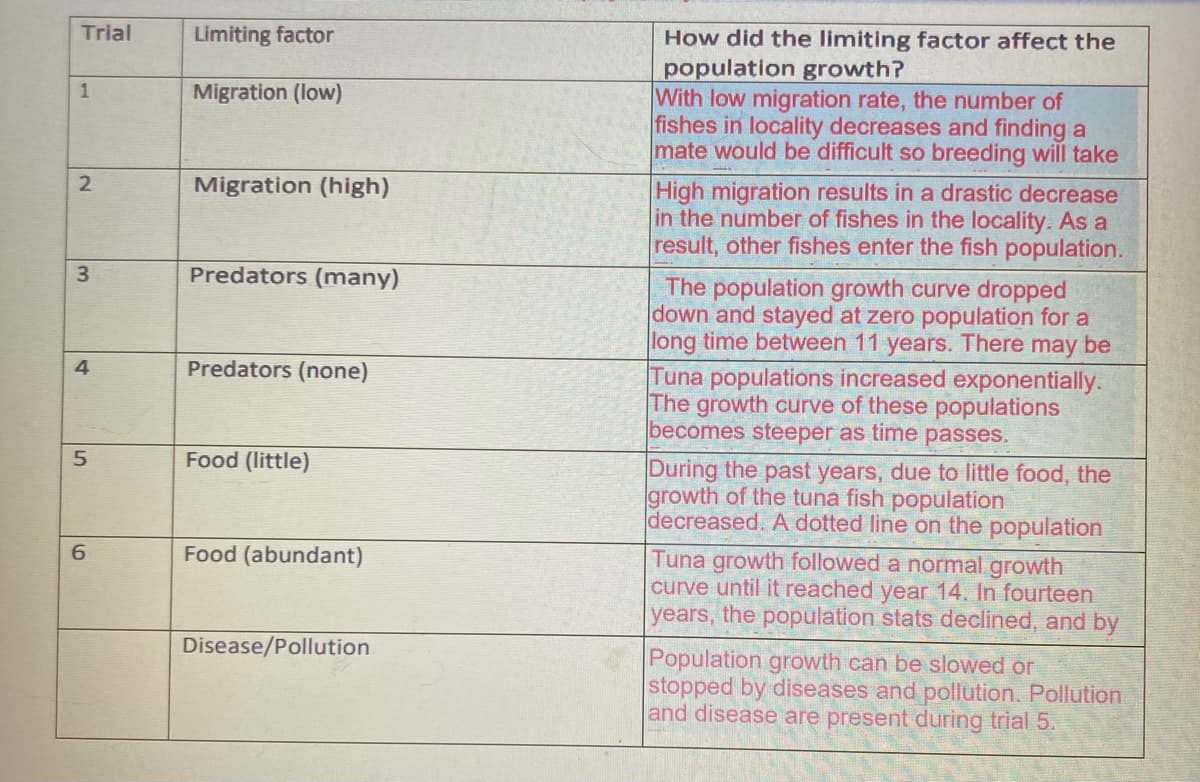Write a conclusion that includes an analysis of various limiting factors and how they impacted population growth. State the purpose of the experiment using the question. Explain the background of the experiment and briefly describe the procedure. When explaining the background of the experiment, you are giving a overview of limiting factors.
Write a conclusion that includes an analysis of various limiting factors and how they impacted population growth. State the purpose of the experiment using the question. Explain the background of the experiment and briefly describe the procedure. When explaining the background of the experiment, you are giving a overview of limiting factors.
Biology: The Unity and Diversity of Life (MindTap Course List)
14th Edition
ISBN:9781305073951
Author:Cecie Starr, Ralph Taggart, Christine Evers, Lisa Starr
Publisher:Cecie Starr, Ralph Taggart, Christine Evers, Lisa Starr
Chapter44: Population Ecology
Section: Chapter Questions
Problem 13SQ: Match each term with its most suitable description. _____ carrying capacity a. maximum rate or...
Related questions
Question
Write a conclusion that includes an analysis of various limiting factors and how they impacted population growth. State the purpose of the experiment using the question. Explain the background of the experiment and briefly describe the procedure. When explaining the background of the experiment, you are giving a overview of limiting factors. You should include information found in the background of the lab. Include a summary of the steps used to gather data. Describe how each of the limiting factors you studied in the simulation affected population growth and carrying capacity ( migration, predation, food, disease, and pollution) include a reason why you think the limiting factor affected the population growth in this way.

Transcribed Image Text:Female cottontail rabbits (Sylvilagus floridanus) are especially fertile, able to give birth to
seven litters a year. While this would suggest areas with cottontail rabbits would be
overrun by them, this isn't the case. Rabbit populations are restricted by factors like food
availability and predation. Due to these limiting factors the rabbit population will only
get so big and that is it's carrying capacity. Carrying capacity can fluctuate depending on
the limiting factors. If there is more predation or little food, then the carrying capacity
will be lower. If there is little predation and abundant food, then the carrying capacity
will be higher because the ecosystem can support a larger population.

Transcribed Image Text:Trial
Limiting factor
How did the limiting factor affect the
population growth?
With low migration rate, the number of
fishes in locality decreases and finding a
mate would be difficult so breeding will take
1
Migration (low)
Migration (high)
High migration results in a drastic decrease
in the number of fishes in the locality. As a
result, other fishes enter the fish population.
3
Predators (many)
The population growth curve dropped
down and stayed at zero population for a
long time between 11 years. There may be
Predators (none)
Tuna populations increased exponentially.
The growth curve of these populations
becomes steeper as time passes.
Food (little)
During the past years, due to little food, the
growth of the tuna fish population
decreased. A dotted line on the population
Food (abundant)
Tuna growth followed a normal growth
curve until it reached year 14. In fourteen
years, the population stats declined, and by
Disease/Pollution
Population growth can be slowed or
stopped by diseases and pollution. Pollution
and disease are present during trial 5.
41
6,
Expert Solution
This question has been solved!
Explore an expertly crafted, step-by-step solution for a thorough understanding of key concepts.
This is a popular solution!
Trending now
This is a popular solution!
Step by step
Solved in 2 steps

Knowledge Booster
Learn more about
Need a deep-dive on the concept behind this application? Look no further. Learn more about this topic, biology and related others by exploring similar questions and additional content below.Recommended textbooks for you

Biology: The Unity and Diversity of Life (MindTap…
Biology
ISBN:
9781305073951
Author:
Cecie Starr, Ralph Taggart, Christine Evers, Lisa Starr
Publisher:
Cengage Learning


Biology: The Unity and Diversity of Life (MindTap…
Biology
ISBN:
9781337408332
Author:
Cecie Starr, Ralph Taggart, Christine Evers, Lisa Starr
Publisher:
Cengage Learning

Biology: The Unity and Diversity of Life (MindTap…
Biology
ISBN:
9781305073951
Author:
Cecie Starr, Ralph Taggart, Christine Evers, Lisa Starr
Publisher:
Cengage Learning


Biology: The Unity and Diversity of Life (MindTap…
Biology
ISBN:
9781337408332
Author:
Cecie Starr, Ralph Taggart, Christine Evers, Lisa Starr
Publisher:
Cengage Learning